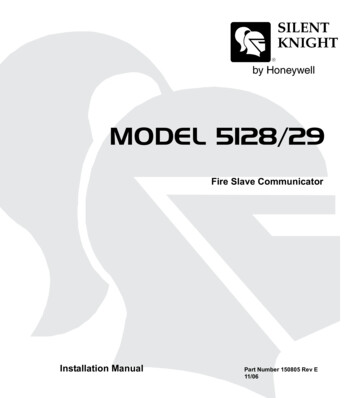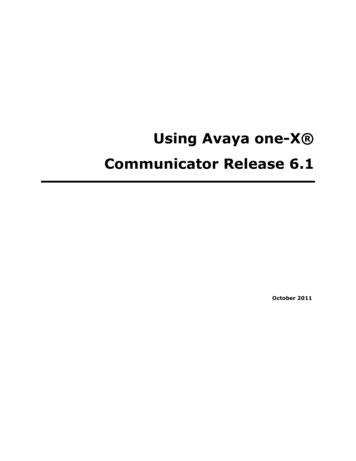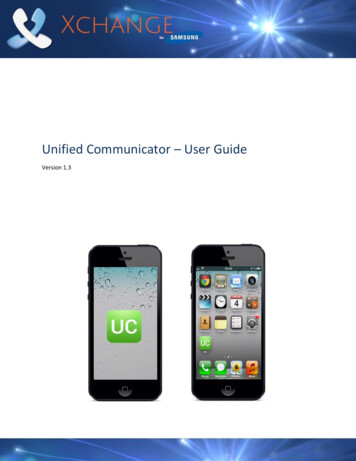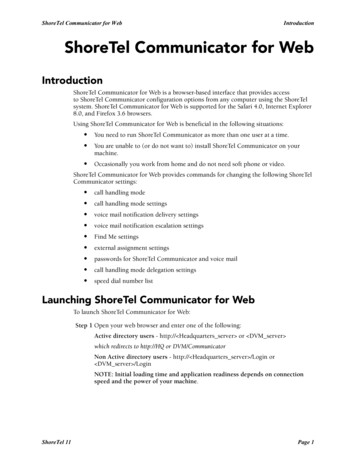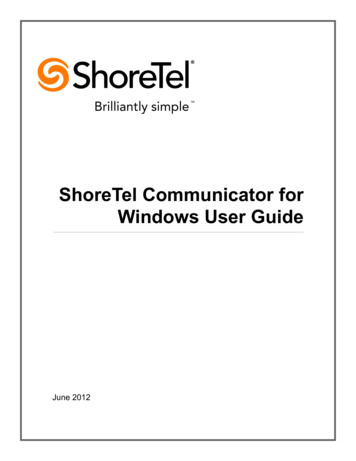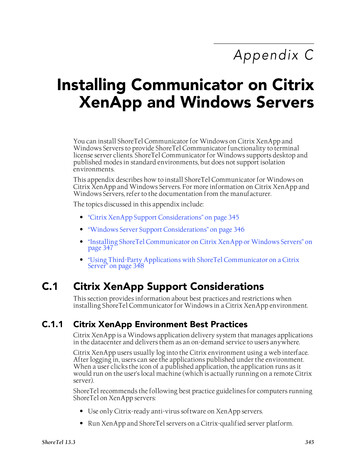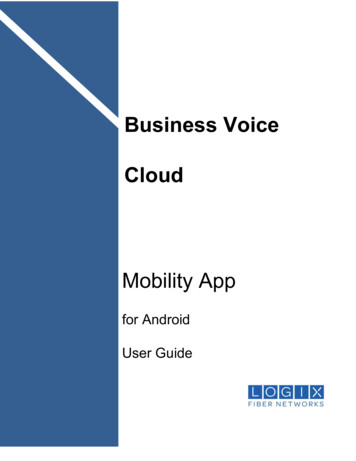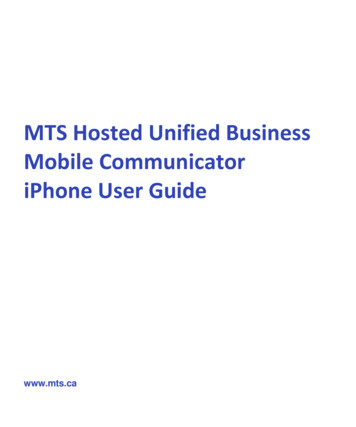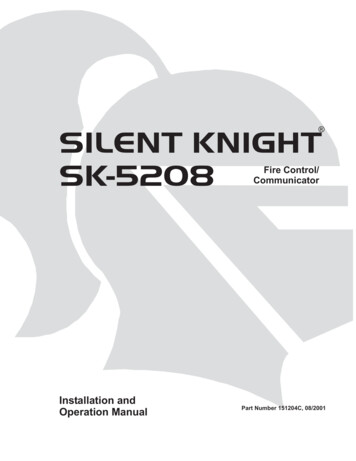
Transcription
SILENT KNIGHTSK-5208 Fire Control/CommunicatorInstallation andOperation ManualPart Number 151204C, 08/2001
ContentSection 1Introduction . 1-11.11.2Model SK-5208 Features . 1-1About This Manual . 1-21.2.1 Optional Accessories . 1-2Limitations of Fire Alarm Systems . 1-3Section 2Agency Listings and Requirements. 2-12.12.2Federal Communications Commission (FCC) . 2-1Underwriters Laboratories (UL) . 2-22.2.1 Requirements for All Installations . 2-22.2.2 Requirements for Central Station Fire Alarm Systems . 2-22.2.3 Requirements for Auxiliary Protected Fire Alarm Systems for Fire Alarm Service . 2-22.2.4 Requirements for Remote Station Protected Fire Alarm Systems, for Digital Communication orPolarity Reversal 2-22.3 Industry Canada Warnings . 2-32.3.1 Avis D’industrie Canada . 2-4Section 3Control Panel Installation. 3-13.13.23.33.43.53.6Electrical Specifications . 3-1Environmental Specifications . 3-1Wiring Specifications . 3-2Control Board Components . 3-3Mounting the SK-5208 . 3-4Current Draw Calculations . 3-53.6.1 Worksheet Requirements . 3-5Filling in the Current Draw Worksheet, Table 3-2 (Section 3.6.2) . 3-53.6.2 Current Draw Worksheet . 3-63.6.3 Maximum Battery Standby Load . 3-73.7 AC Wiring . 3-83.8 Backup Batteries . 3-93.9 Terminal Strip Description . 3-103.10 Telephone Line Connection . 3-123.11 Detector Installation . 3-133.11.1 Class A (Style D) Zones . 3-133.11.2 Class B (Style B) Zones . 3-143.11.3 Four-Wire Smoke Detector Connection . 3-153.11.4 Two-Wire Smoke Detector Connection . 3-163.12 Supervised Notification Appliance Outputs . 3-173.13 Auxiliary Relays . 3-18P/N 1512041
Model SK-5208 Fire Control/Communicator Installation and Operation Manual3.14 Accessory Devices . 3-193.14.1 Setting ID Codes . 3-193.14.2 Model SK-5235 Remote Annunciator . 3-203.14.2.1 Mounting the SK-5235 Remote Annunciator . 3-203.14.2.2 Wiring the SK-5235 . 3-213.14.3 Model SK-5280 Status Display Module . 3-223.14.3.1 Mounting the SK-5280 . 3-24Mounting the SK-5280 into SK-5208 Cabinet . 3-24Mounting the SK-5280 into the SK-2190 Accessory Cabinet. . 3-253.14.3.2 Wiring Relays . 3-263.14.3.3 Wiring LEDs to Outputs . 3-263.14.4 Model SK-5217 Zone Expander Installation . 3-273.14.4.1 Zone Inputs . 3-283.14.4.2 Mounting Instructions . 3-29Mounting the SK-5217 into SK-5208 Cabinet . 3-29Mounting the SK-5217 into the SK-2190 Accessory Cabinet. . 3-303.15 Special Applications . 3-313.15.1 Model 5220 Direct Connect Module . 3-313.15.1.1 City Box Connection . 3-313.15.1.2 NFPA 72 Polarity Reversal . 3-323.15.2 Keltron 95M3158 Tones Transmitter Module . 3-33Section 4Programming. 4-14.1Keypad Operation During Programming . 4-14.1.1 Special Characters . 4-24.1.2 Enabling Extended Programming List . 4-24.2 Programming Flow . 4-34.2.1 Zone Options . 4-44.2.2 Misc System Option . 4-54.2.3 NAC Cadence . 4-64.2.3.1 Cadence Patterns . 4-64.2.4 NAC Options . 4-74.2.5 Relay Options . 4-84.2.6 User Code . 4-94.2.7 Account . 4-104.2.8 Computer Options . 4-114.2.8.1 Computer Code . 4-114.2.9 Line Options . 4-124.2.10 Misc Reporting . 4-134.2.11 5280 Outputs . 4-144.3 Programming Options . 4-15Section 5Operation5.15.25.35.42. 5-1On-board Touchpad and SK-5235 Operation . 5-2Acknowledge Operation . 5-3LED Indicators . 5-3Releasing Operation . 5-4P/N 151204
Content5.4.1 Cross Alarm Operation . 5-45.4.1.1 Default NAC Settings for Releasing . 5-45.4.2 Double Interlock Releasing Operation . 5-65.5 Smoke Alarm Verification . 5-75.6 System Testing . 5-85.6.1 Fire Drills . 5-85.6.2 Walk Test . 5-85.6.3 Automatic Self Test . 5-85.6.4 Watchdog Circuit . 5-85.7 Communicating with a Programming Computer . 5-95.7.1 Programming From a Remote Computer Location . 5-95.7.1.1 Having the Control Panel Call the Remote Computer . 5-95.7.1.2 Having Remote Computer Call the Control Panel . 5-105.7.2 Directly Connecting to a Programming Computer . 5-11Section 6Reporting6.16.2. 6-1Reporting Formats . 6-1Reporting Codes . 6-2Section 7Troubleshooting7.17.2. 7-1System Error Messages . 7-1Earth Ground Fault Troubleshooting . 7-3Appendix ACompatible DevicesA.1A.2. A-1Smoke Detectors . A-1Two-Wire Smoke Detectors . A-2Four Wire Smoke Detectors . A-4Notification Appliances . A-5P/N 1512043
Model SK-5208 Fire Control/Communicator Installation and Operation Manual4P/N 151204
Section 1IntroductionThe Model SK-5208 is an 24-volt 10-zone fire alarm control panel (expandable up to 30 zonesusing SK-5217 Zone Expanders) with a digital communicator that meets NFPA 72requirements. The SK-5208 cabinet can be surface mounted or semi-flush mounted.1.1Model SK-5208 Features Built-in two-line (16 Character each line) LCD display provides easy to read englishlanguage readouts 10 Initiation inputs, 8 Class B (Style B) and 2 zones that can be configured as Class B(Style B) or Class A (Style D), expandable to 30 zones Supervised zone expanders and I/O modules can be mounted remotely from the maincontrol panel UL Listed Event History Buffer (approximately 150 events) with Date/Time stamp All zones are compatible with 2- and 4-wire detectors 8 selectable/programmable output pattern for notification appliance circuits (IncludingANSI 3.41) Built-in Digital Alarm Communicator Transmitter (DACT) 4 Notification appliance circuits 4 programmable general purpose relays Programmable smoke verification, pre-alarm delay, cross zoning and enhancedverification mode features that can help minimize false alarms Capable of single or dual operation for water releasing services. Programmable from the built-in control panel touchpad, remote annunciator or Window downloading software Built-in walk testP/N 1512041-1
Model SK-5208 Fire Control/Communicator Installation and Operation Manual1.2About This ManualThe Model SK-5208 Fire Control/Communicator Installation Manual (P/N 151204) isintended for those persons involved with the installation and maintenance of the SK-5208panel. It is a comprehensive guide, providing detailed instructions, and should be kept forreference. As much as possible, we have tried to organize the manual chronologically by thetasks that need to be performed.Table 1-1: Standards Used in this ManualA same graphic replicating the key that you press on a touchpad.1LCD DISPLAY MESSAGEThe font shown to the left represents messages that you see on a liquid crystaldisplay (LCD) on the control panel and the remote annunciator.1-1, 2-3, etc.This manual is organized into sections. Section numbers are part of the pagenumbers. For example, 1-1 means Page 1 of Section 1.1.2.1Optional AccessoriesTable 1-2: Compatible Modules Manufactured by Silent KnightModel1-2What It DoesSK-5217 Zone ExpanderAdds 10 zones to the SK-5208 for a total expansion of the system to 30zones.SK-2190 Accessory CabinetUsed for remote mounting of the SK-5217 Zone Expander.5220 Direct Connect ModuleFor direct alarming and trouble transmission from the SK-5208 to asupervising station.SK-5235 Remote AnnunciatorFor remote annunciation, operation, and on-site programming.SK-5280The Model SK-5280 Status Display module provides outputs and controlfunctions for remote annunciation of alarm, trouble, and supervisoriesfor each zone.SK-5495 Signal Power ExpanderNotification circuit power for additional notification appliances.Provides additional 6A of 24 VDC, supervised.SKSS Downloading SoftwareModel 5660For remote programming of the SK-5208 using a personal computer.7181 Zone ConverterConverts a zone from Class B to Class A or from Class A to Class B.One 7181 per zone to be converted.P/N 151204
IntroductionLimitations of Fire Alarm SystemsManufacturer recommends that smoke and/or heat detectors be located throughout a protected premise following therecommendations of the current edition of the National Fire Protection Association Standard 72 (NFPA 72), manufacturer’srecommendations, State and local codes, and the recommendations contained in Guide for the Proper Use of System SmokeDetectors, which is made available at no charge to all installing dealers. A study by the Federal Emergency ManagementAgency (an agency of the United States government) indicated that smoke detectors may not go off or give early warning in asmany as 35% of all fires. While fire alarm systems are designed to provide warning against fire, they do not guarantee warningor protection against fire. A fire alarm system may not provide timely or adequate warning, or simply may not function, for avariety of reasons. For example: Particles of combustion or smoke from a developing fire may not reach the sensing chambers of smoke detectors because:- Barriers such as closed or partially closed doors, walls, or chimneys may inhibit particle or smoke flow.- Smoke particles may become cold, stratify, and not reach the ceiling or upper walls where detectors are located.- Smoke particles may be blown away from detectors by air outlets- Smoke particles may be drawn into air returns before reaching the detector. In general, smoke detectors on one level of a structure cannot be expected to sense fires developing on another level.The amount of smoke present may be insufficient to alarm smoke detectors. Smoke detectors are designed to alarm atvarious levels of smoke density. If such density levels are not created by a developing fire at the location of detectors, thedetectors will not go into alarm.Smoke detectors, even when working properly, have sensing limitations. Detectors that have photoelectronic sensingchambers tend to detect smoldering fires better than flaming fires, which have little visible smoke. Detectors that haveionizing-type sensing chambers tend to detect fast flaming fires better than smoldering fires. Because fires develop indifferent ways and are often unpredictable in their growth, neither type of detector is necessarily best and a given type ofdetector may not provide adequate warning of a fire.Smoke detectors are subject to false alarms and nuisance alarms and may have been disconnected by users. For example,a smoke detector located in or near a kitchen may go into nuisance alarm during normal operation of kitchen appliances.In addition, dusty or steamy environments may cause a smoke detector to falsely alarm. If the location of a smokedetector causes an abundance of false alarms or nuisance alarms, do not disconnect the smoke detector; call a professionalto analyze the situation and recommend a solution.Smoke detectors cannot be expected to provide adequate warning of fires caused by arson, children playing with matches(especially within bedrooms), smoking in bed, violent explosions (caused by escaping gas, improper storage of flammablematerials, etc.).Heat detectors do not sense particles of combustion and are designed to alarm only when heat on their sensors increases ata predetermined rate or reaches a predetermined level. Heat detectors are designed to protect property, not life.Warning devices (including horns, sirens, and bells) may not alert people or wake up sleepers who are located on the otherside of closed or partially open doors. A warning device that activates on a different floor or level of a dwelling orstructure is less likely to awaken or alert people. Even persons who are awake may not notice the warning if the alarm ismuffled by noise from a stereo, radio, air conditioner or other appliance, or by passing traffic. Audible warning devicesmay not alert the hearing-impaired (strobes or other devices should be provided to warn these people). Any warningdevice may fail to alert people with a disability, deep sleepers, people who have recently used alcohol or drugs, or peopleon medication or sleeping pills.- Please note that:i) Strobes can, under certain circumstances, cause seizures in people with conditions such as epilepsy.ii) Studies have shown that certain people, even when they hear a fire alarm signal, do not respond or comprehendthe meaning of the signal. It is the property owner’s responsibility to conduct fire drills and other training exercises to make people aware of fire alarm signals and instruct on the proper reaction to alarm signals.iii) In rare instances, the sounding of a warning device can cause temporary or permanent hearing loss.Telephone lines needed to transmit alarm signals from a premises to a central station may be out of service or temporarilyout of service. For added protection against telephone line failure, backup radio transmission systems are recommended.System components, though designed to last many years, can fail at any time. As a precautionary measure, it isrecommended that smoke detectors be checked, maintained, and replaced per manufacturer's recommendations.System components will not work without electrical power. If system batteries are not serviced or replaced regularly,they may not provide battery backup when AC power fails.Environments with high air velocity or that are dusty or dirty require more frequent maintenance.P/N 1512041-3
Model SK-5208 Fire Control/Communicator Installation and Operation ManualIn general, fire alarm systems and devices will not work without power and will not function properly unless theyare maintained and tested regularly.While installing a fire alarm system may make the owner eligible for a lower insurance rate, an alarm system isnot a substitute for insurance. Property owners should continue to act prudently in protecting the premises andthe people in their premises and should properly insure life and property and buy sufficient amounts of liabilityinsurance to meet their needs.1-4P/N 151204
Section 2Agency Listings and Requirements2.1Federal Communications Commission (FCC)1. If requested by the telephone company, the following information must be providedbefore the SK-5208 can be connected to the phone lines:A.Manufacturer:Silent KnightA.Model Number:SK-5208B.FCC registration number:AC6USA-34758-AL-ERinger equivalence:0.5BType of jack (to be installed by the telephone company):RJ31XC.4. This device may not be directly connected to coin telephone or party line services.5. This device cannot be adjusted or repaired in the field. In case of trouble with the device,notify the installing company or return to:Silent Knight7550 Meridian CircleMaple Grove, MN 55369-4927612-493-6455800-328-01036. If the SK-5208 causes harm to the telephone network, the telephone company will notifythe user in advance that temporary discontinuance of service may be required. Whenadvance notice is not practical, the telephone company will notify the user as soon aspossible. Users have the right to file complaints, if necessary, with the FederalCommunications Commission.7. The telephone company may make changes in its facilities, equipment, operations, orprocedures that could affect the operation of the equipment. If this happens, the telephonecompany will provide advance notice to allow you to make the necessary modifications tomaintain uninterrupted service.WarningThis device has been verified to comply with FCC Rules Part 15. Operation is subject to the two followingconditions: (1) This device may not cause radio interference; and (2) This device must accept anyinterference received including interference that may cause undesired operation.P/N 1512042-1
Model SK-5208 Fire Control/Communicator Installation and Operation Manual2.2Underwriters Laboratories (UL)The SK-5208 is UL Listed as a control unit for use in Central Station Protected Premises,Local Protected Fire Alarm Systems, Auxiliary Protected Fire Alarm Systems for Fire AlarmService (City Box), Remote Station Protected Fire Alarm Systems and water releasingservice. If the SK-5208 and its accessories are to be used as part of a UL installation, carefullyread the UL requirements in this section.2.2.1Requirements for All InstallationsGeneral requirements are described below. The sections that follow describe additionalrequirements for the type of installation (for example, Central Station Fire Alarm systems,Local Protected Fire Alarm systems, and so on).1. Use UL listed smoke detectors compatible with the SK-5208. Refer to Appendix A.2. Use UL listed compatible notification devices. Refer to Appendix A.2.2.2Requirements for Central Station Fire AlarmSystems1. The Phone Line “Line Dial Type” must be selected for anything other than “Not Used”.(See programming Section 4.2.9).2. On class A (style D) zones, the number of waterflow devices is limited to five.3. Auxiliary relays may not be programmed to activate for Pre-Alarm. See programmingSection 4.2.5.2.2.3Requirements for Auxiliary Protected Fire AlarmSystems for Fire Alarm Service1. Follow the current load restrictions shown in Section 3.6.2. The Model 5220 Direct Connect module must be installed (see Section 3.15.1 for wiring).2.2.4Requirements for Remote Station Protected FireAlarm Systems, for Digital Communication orPolarity Reversal1. Follow the current load restrictions shown in Section 3.6.2. Use the SK-5208’s built-in dialer or install the Model 5220 Direct Connect Module (seeSection 3.15.1).2-2P/N 151204
Agency Listings and Requirements2.3Industry Canada WarningsNOTICE:The Industry Canada Label identifies certified equipment. This certification means that theequipment meets telecommunications network protective, operational and safety requirementsas prescribed in the appropriate Terminal Equipment Technical Requirements document(s).The Department does not guarantee the equipment will operate to the user’s satisfaction.Before installing this equipment, users should ensure that it is permissible to be connected tothe facilities of the local telecommunications company. The equipment must also be installedusing an acceptable method of connection. The customer should be aware that compliancewith the above conditions may not prevent degradation of service in some situations.Repairs to certified equipment should be coordinated by a representative designated by thesupplier. Any repairs or alterations made by the user to this equipment, or equipmentmalfunctions, may give the telecommunications company cause to request the user todisconnect the equipment.Users should ensure for their own protection that the electrical ground connections of thepower utility, telephone lines and internal metallic water pipe system, if present, areconnected together. This precaution may be particularly important in rural areas.Caution: Users should not attempt to make such connections themselves, but should contactthe appropriate electric inspection authority, or electrician, as appropriate.NOTICE: The Ringer Equivalence Number (REN) assigned to each terminal device providesan indicatio
Table 1-2: Compatible Modules Manufactured by Silent Knight Model What It Does SK-5217 Zone Expander Adds 10 zones to the SK-5208 for a total expansion of the system to 30 zones. SK-2190 Accessory Cabinet Used for remote mounting of the SK-5217 Zone Expander. 5220 Direct Connect Module For direct alarming and trouble transmission from the SK .
